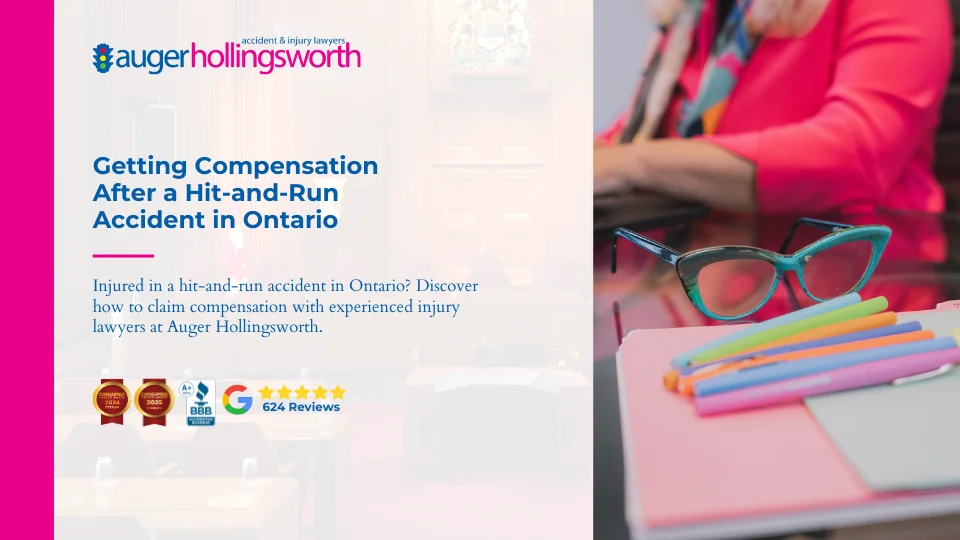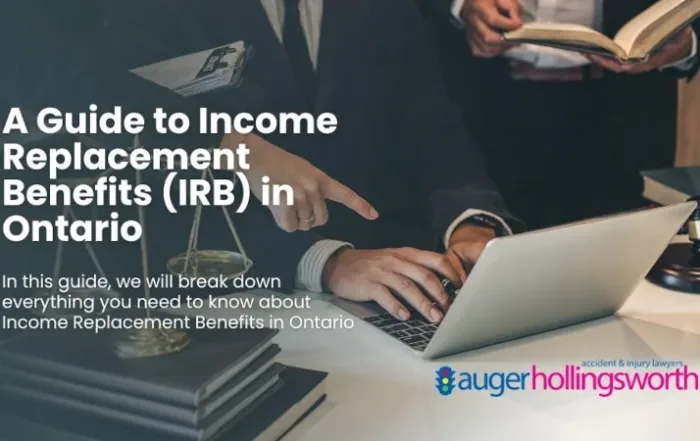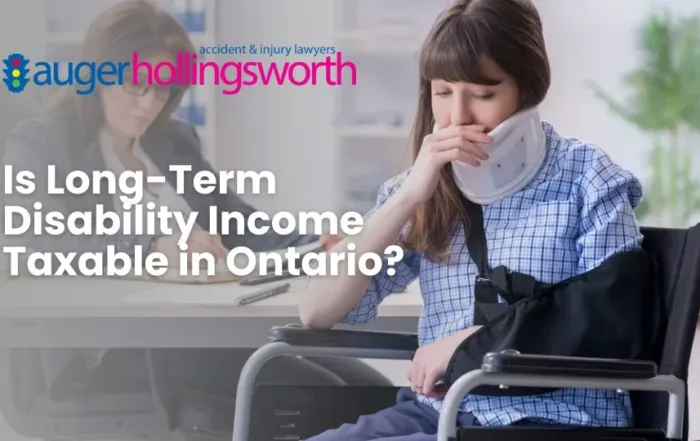Getting Compensation After a Hit-and-Run Accident in Ontario

Few experiences are more upsetting or unfair than being hit by a driver who speeds away. Whether you were driving, cycling, or walking, a hit-and-run collision can leave you injured, shaken, and wondering who will pay for your losses.
At Auger Hollingsworth Injury and Accident Lawyers, we regularly represent people across Ontario who were injured by drivers who fled the scene. The good news is that even if the other driver is never found, you still have legal options for compensation. This article explains what happens after a hit-and-run, how police and insurers handle these cases, and what you can do to protect your rights.
What Counts as a Hit-and-Run?
In Ontario, any driver involved in a collision is required to remain at the scene, provide their name, address, driver’s licence number, and insurance information, and offer assistance if someone is injured.
A hit-and-run occurs whenever a driver fails to do these things — even if they stop briefly and then leave without identifying themselves or waiting for police. Leaving a scene prematurely still qualifies as a hit-and-run and can lead to criminal charges under the Criminal Code or the Highway Traffic Act.
Hit-and-run cases can involve:
- Vehicle-to-vehicle collisions, where one driver flees;
- Cyclists, who are struck by a car whose driver fails to stop;
- Pedestrians, hit while crossing or walking along the road;
- Parked vehicles, damaged in parking lots or on residential streets without a note or report.
In every scenario, the fleeing driver’s conduct complicates recovery, but it does not end your right to claim compensation.
What the Police Will Do
When you report a hit-and-run, police will open an investigation. They will typically:
- Visit the scene, take statements, and gather debris or paint transfer from the striking vehicle;
- Check for surveillance footage — from traffic lights, nearby businesses, or residential doorbell cameras;
- Circulate a vehicle description or partial licence plate if available; and
- In serious injury cases, issue media releases or public appeals for witnesses.
In urban areas, the number of security and doorbell cameras has made it much easier to identify hit-and-run drivers. In smaller towns or rural locations, the search may take longer and rely more on witnesses or physical evidence such as skid marks or broken parts at the scene.
If the police find the responsible driver, your case will proceed like any other motor-vehicle injury claim — except that the driver’s decision to flee may strengthen your case. Fleeing the scene demonstrates recklessness and disregard for safety, factors a court may consider when assessing credibility and damages.
If the Driver Is Found
Once the driver is identified, your lawyer will file a civil claim against the driver and vehicle owner (and their insurer). The claim proceeds as a normal personal injury lawsuit for damages such as:
- Pain and suffering;
- Loss of income or earning capacity;
- Out-of-pocket medical expenses;
- Housekeeping and care costs; and
- Family Law Act claims by close relatives.
Because fleeing the scene is viewed as serious misconduct, juries and judges tend to view plaintiffs in hit-and-run cases sympathetically. In rare situations, courts may even consider punitive damages to express condemnation of the driver’s behaviour.
If the Driver or Vehicle Is Never Found
Even when the at-fault driver disappears, you still have options. Ontario’s insurance system provides protection through unidentified motorist coverage and through the Ontario Policy Change Form (OCP 44R) — a standard endorsement attached to most automobile insurance policies.
Unidentified Motorist Coverage: How It Works
Every Ontario auto insurance policy automatically includes coverage for accidents involving uninsured or unidentified vehicles. This means that if you are injured by a driver who leaves the scene and is never found, you can still claim compensation — usually from your own insurer.
This coverage is triggered when:
- The accident occurs in Ontario or another Canadian province (or a U.S. state with reciprocal recognition);
- The at-fault vehicle or driver cannot be identified after reasonable efforts; and
- Your injuries arise directly from the use or operation of that unidentified vehicle.
Importantly, this coverage also extends to pedestrians and cyclists struck by an unidentified motorist, even if they did not own a vehicle themselves. In that case, a claim may be made through:
- The insurer of a household family member; or
- If no policy applies, the Motor Vehicle Accident Claims Fund (MVACF) — a provincial backstop designed to compensate victims of uninsured or unidentified driv
Understanding OCP 44R Coverage
The Ontario Policy Change Form 44R (Family Protection Endorsement) is an optional but very common add-on to auto insurance policies in Ontario. Many people don’t even realize they have it until an accident happens.
The OCP 44R steps in when you are injured by an at-fault driver who is uninsured, underinsured, or unidentified. It ensures you receive at least the same amount of coverage you would have had if the responsible driver carried insurance equal to your own policy limits.
For example:
If you have $1,000,000 in third-party liability coverage and are struck by an unidentified hit-and-run driver, your OCP 44R coverage can respond up to that same limit.
To qualify, you must:
- Be an insured person under a policy that includes the OCP 44R;
- Prove that the accident was caused by the unidentified motorist; and
- Meet the corroboration requirement — evidence beyond your own word that the accident involved another vehicle.
The Corroboration Requirement
To prevent fraudulent claims, the law requires independent corroboration when the at-fault vehicle or driver cannot be identified. This means your own statement about the crash must be supported by some objective evidence, such as:
- A witness statement confirming that another vehicle was involved;
- Physical evidence like paint transfer, broken parts, or tire marks; or
- Video footage from dashcams, surveillance, or nearby doorbells.
Corroboration does not require the other driver to be identified — only proof that another vehicle existed and caused the collision. Your lawyer will help gather and preserve this evidence quickly, since surveillance footage is often deleted within days.
If no corroboration is available (for instance, in a single-vehicle collision without witnesses or camera footage), compensation under unidentified-driver coverage may be more difficult. That’s why it’s essential to call police immediately, photograph the scene, and speak to anyone nearby who might have seen what happened.
Steps to Take After a Hit-and-Run Accident
If you are involved in a hit-and-run, here’s what to do:
- Call 911 right away. Report the collision to police as soon as possible. A prompt report strengthens both the investigation and your insurance claim.
- Gather details. Note the colour, make, or partial licence plate of the fleeing vehicle if you can do so safely.
- Look for witnesses or cameras. Ask nearby drivers, pedestrians, or businesses if they saw anything. Many intersections, buildings, and homes have cameras that could capture the event.
- Seek medical attention. Even if you feel okay, get checked. Some injuries, including concussions and soft-tissue trauma, develop slowly.
- Notify your insurer. Report the accident within seven days. Mention that it was a hit-and-run and that the other vehicle is unidentified.
- Call a lawyer experienced in hit-and-run claims. We will ensure that every coverage avenue is explored — your policy, a household member’s policy, or the MVACF if necessary.
The Police Investigation: City vs. Rural Cases
In major cities, police can often track fleeing drivers using traffic cameras, transit footage, and doorbell recordings. Many cases are solved within days because there’s so much video evidence available.
In rural areas or small towns, the investigation can be harder. Fewer cameras and greater distances between homes and businesses mean fewer leads. However, even rural investigations can succeed through careful collection of vehicle debris, skid marks, or witness accounts from passing motorists.
Whether the police find the culprit or not, your right to compensation remains through the insurance system.
If the Driver Is Found vs. Not Found
- If found: The case proceeds like any normal negligence claim, and the driver’s attempt to flee will likely make their defence less credible.
- If not found: Your lawyer will pursue a claim under your unidentified motorist or OCP 44R coverage. You can still recover for pain and suffering, income loss, and other damages.
Either way, you are not without recourse. The system exists to protect innocent victims, not penalize them for another person’s misconduct.
Don’t Be Discouraged — You Still Have a Claim
A hit-and-run collision can feel like a betrayal. It’s frightening to realize someone caused you harm and drove away without even checking if you were alive. But you should not lose hope or assume that you’re on your own.
Ontario’s insurance laws provide multiple safety nets for exactly this situation. With prompt reporting, proper documentation, and experienced legal help, you can still receive full compensation for your injuries and losses.
At Auger Hollingsworth Injury and Accident Lawyers, we handle hit-and-run cases across Ontario — for drivers, passengers, cyclists, and pedestrians. We know how to coordinate with police, preserve video evidence, and navigate the complex insurance process to ensure you get the compensation you deserve.
If you’ve been injured in a hit-and-run, don’t wait. Evidence disappears quickly, and strict deadlines apply.
📞 Call 1-888-574-4529 to schedule your free consultation. We’ll explain your options, contact the right insurers, and take care of the paperwork so you can focus on recovery.
Even if the driver is never found — you still have a claim. Let us help you move forward.














